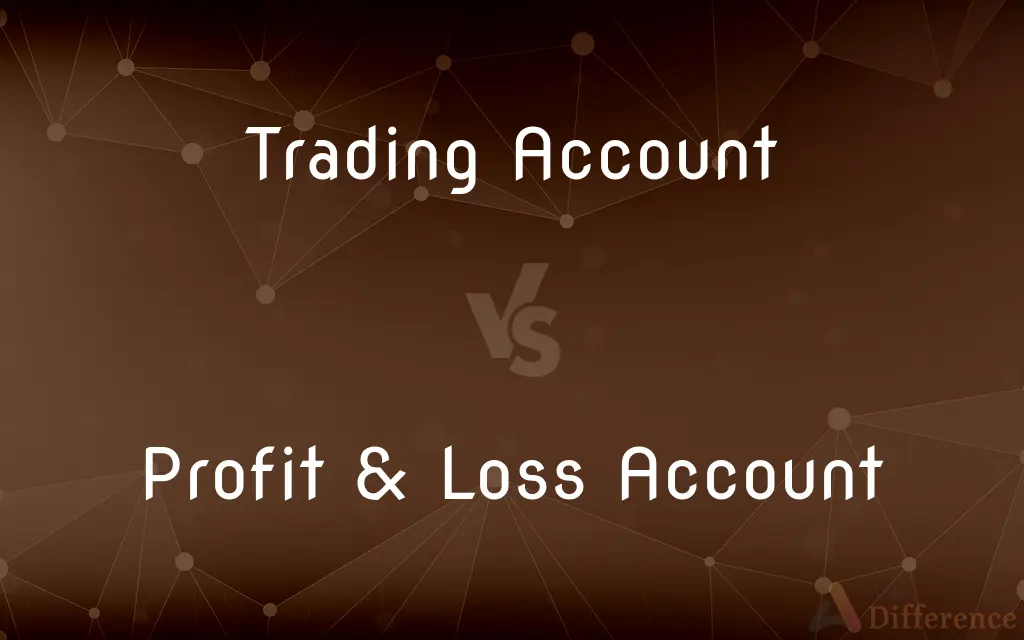Trading Account vs. Profit & Loss Account — What's the Difference?
By Tayyaba Rehman — Published on October 8, 2023
A Trading Account shows the result of buying and selling goods, focusing on gross profit or loss, while a Profit & Loss Account illustrates a company’s overall financial performance, detailing net profit or loss.

Difference Between Trading Account and Profit & Loss Account
Table of Contents
ADVERTISEMENT
Key Differences
The Trading Account is a financial statement that reflects the gross profit or loss of a business from its core trading activities. In contrast, the Profit & Loss Account is a comprehensive financial statement that depicts the overall financial performance of a business, including its net profit or loss. Both are essential components of a company’s final accounts, providing distinct insights into its financial health.
The Trading Account primarily focuses on the buying and selling of goods and is concerned with the gross profit or loss made by the company. It calculates the difference between the sales and the cost of goods sold. However, the Profit & Loss Account takes a broader view, including all incomes and expenses, whether they are from the core trading activities or other peripheral activities, to calculate the net profit or loss.
A Trading Account is essential for companies dealing in buying and selling of goods as it helps in determining the efficiency of trading operations. It is pivotal in ascertaining how well a company is performing in its core business activities. On the other hand, a Profit & Loss Account is indispensable for stakeholders to gauge the overall profitability and assess the financial viability of a company, considering all revenue streams and expenditures.
The Trading Account does not account for indirect expenses and incomes; it is solely concerned with direct expenses and revenues related to trading activities. Conversely, the Profit & Loss Account comprehensively includes both indirect and direct expenses and incomes, giving a fuller picture of the company’s financial status.
The Trading Account and Profit & Loss Account serve complementary roles; the gross profit derived from the Trading Account is carried forward to the Profit & Loss Account, where after considering all other incomes and expenses, the net profit or loss is derived. These accounts, when analyzed together, provide a thorough understanding of a company's operational efficiency and overall profitability.
ADVERTISEMENT
Comparison Chart
Focus
Gross profit or loss from trading activities
Net profit or loss, considering all incomes and expenses
Inclusion
Direct expenses and revenues related to trading
Both indirect and direct expenses and incomes
Purpose
Determine efficiency in core business activities
Assess overall profitability and financial viability
Extent of Financial Overview
Limited to buying and selling of goods
Comprehensive, includes all financial activities
Relevance
Essential for businesses dealing in goods
Indispensable for stakeholders assessing financial health
Compare with Definitions
Trading Account
Concerned solely with the buying and selling of goods.
A well-managed Trading Account is indicative of profitable buying and selling transactions.
Profit & Loss Account
Depicts the overall financial performance, detailing net profit or loss.
The Profit & Loss Account is crucial for stakeholders to understand a company’s financial health.
Trading Account
Helps in determining the efficiency of trading operations.
Businesses utilize the Trading Account to optimize their core trading activities.
Profit & Loss Account
Essential for assessing a company’s overall profitability and viability.
Stakeholders rely on the Profit & Loss Account to evaluate the overall profitability of a company.
Trading Account
Provides a limited financial overview, focusing on gross profit or loss.
A Trading Account offers a narrowed view of the financial gains or losses from trading.
Profit & Loss Account
Represents the net result after considering all revenues and expenditures.
The Profit & Loss Account ultimately illustrates whether a company is operating at a net profit or loss.
Trading Account
Reflects gross profit or loss from core trading activities.
The Trading Account is pivotal for analyzing the efficiency of a company’s trading operations.
Profit & Loss Account
Offers a comprehensive financial overview, including all financial activities.
The Profit & Loss Account is indispensable for a thorough understanding of a company's financial activities.
Trading Account
Focuses on direct expenses and revenues related to trading.
The Trading Account provides insights into the direct costs and earnings from trading activities.
Profit & Loss Account
Includes both indirect and direct expenses and incomes.
A Profit & Loss Account provides a comprehensive view of all financial transactions, direct and indirect.
Common Curiosities
A Trading Account shows the result of buying and selling goods, focusing on gross profit or loss, while a Profit & Loss Account illustrates a company’s overall financial performance, detailing net profit or loss.
The Trading Account is a financial statement that reflects the gross profit or loss of a business from its core trading activities. In contrast, the Profit & Loss Account is a comprehensive financial statement that depicts the overall financial performance of a business, including its net profit or loss. Both are essential components of a company’s final accounts, providing distinct insights into its financial health.
InclusionDirect expenses and revenues related to tradingBoth indirect and direct expenses and incomes
PurposeDetermine efficiency in core business activitiesAssess overall profitability and financial viability
The Trading Account primarily focuses on the buying and selling of goods and is concerned with the gross profit or loss made by the company. It calculates the difference between the sales and the cost of goods sold. However, the Profit & Loss Account takes a broader view, including all incomes and expenses, whether they are from the core trading activities or other peripheral activities, to calculate the net profit or loss.
A Trading Account is essential for companies dealing in buying and selling of goods as it helps in determining the efficiency of trading operations. It is pivotal in ascertaining how well a company is performing in its core business activities. On the other hand, a Profit & Loss Account is indispensable for stakeholders to gauge the overall profitability and assess the financial viability of a company, considering all revenue streams and expenditures.
Concerned solely with the buying and selling of goods.
A well-managed Trading Account is indicative of profitable buying and selling transactions.
Includes both indirect and direct expenses and incomes.
A Profit & Loss Account provides a comprehensive view of all financial transactions, direct and indirect.
The Trading Account does not account for indirect expenses and incomes; it is solely concerned with direct expenses and revenues related to trading activities. Conversely, the Profit & Loss Account comprehensively includes both indirect and direct expenses and incomes, giving a fuller picture of the company’s financial status.
The Trading Account and Profit & Loss Account serve complementary roles; the gross profit derived from the Trading Account is carried forward to the Profit & Loss Account, where after considering all other incomes and expenses, the net profit or loss is derived. These accounts, when analyzed together, provide a thorough understanding of a company's operational efficiency and overall profitability.
Difference AspectTrading AccountProfit & Loss Account
FocusGross profit or loss from trading activitiesNet profit or loss, considering all incomes and expenses
Focuses on direct expenses and revenues related to trading.
The Trading Account provides insights into the direct costs and earnings from trading activities.
Helps in determining the efficiency of trading operations.
Businesses utilize the Trading Account to optimize their core trading activities.
Essential for assessing a company’s overall profitability and viability.
Stakeholders rely on the Profit & Loss Account to evaluate the overall profitability of a company.
Extent of Financial OverviewLimited to buying and selling of goodsComprehensive, includes all financial activities
RelevanceEssential for businesses dealing in goodsIndispensable for stakeholders assessing financial health
Represents the net result after considering all revenues and expenditures.
The Profit & Loss Account ultimately illustrates whether a company is operating at a net profit or loss.
What is the main focus of a Trading Account?
The Trading Account mainly focuses on gross profit or loss resulting from core trading activities.
Is Trading Account concerned with indirect expenses and incomes?
No, Trading Account only deals with direct expenses and revenues related to trading activities.
Which account provides a more comprehensive view of a company’s financial status?
The Profit & Loss Account provides a more comprehensive view compared to the Trading Account.
Reflects gross profit or loss from core trading activities.
The Trading Account is pivotal for analyzing the efficiency of a company’s trading operations.
Does the Profit & Loss Account include indirect expenses and incomes?
Yes, the Profit & Loss Account includes both indirect and direct expenses and incomes.
What does the Trading Account help in determining?
The Trading Account helps in determining the gross profit or loss from the buying and selling of goods.
Can a Trading Account and a Profit & Loss Account be analyzed independently for a company’s overall financial health?
While they provide different insights, analyzing both together offers a more thorough understanding of a company's financial health.
Provides a limited financial overview, focusing on gross profit or loss.
A Trading Account offers a narrowed view of the financial gains or losses from trading.
Why is a Trading Account important for businesses dealing in goods?
It helps in determining the efficiency of trading operations and in optimizing core trading activities.
Does Trading Account provide insights into a company’s overall profitability?
No, it only provides insights into the profitability of the company’s core trading activities.
Can the Profit & Loss Account illustrate the efficiency of core business activities?
While it shows overall profitability, the Trading Account is more indicative of the efficiency of core business activities.
Why is a Profit & Loss Account important for stakeholders?
It allows stakeholders to assess the overall profitability and financial viability of a company.
Depicts the overall financial performance, detailing net profit or loss.
The Profit & Loss Account is crucial for stakeholders to understand a company’s financial health.
Offers a comprehensive financial overview, including all financial activities.
The Profit & Loss Account is indispensable for a thorough understanding of a company's financial activities.
What does a Profit & Loss Account depict?
A Profit & Loss Account depicts the overall financial performance of a company, showing net profit or loss.
What is the extent of the financial overview provided by a Profit & Loss Account?
It provides a comprehensive financial overview, including all the financial activities of a company.
What financial aspects does a Profit & Loss Account consider to depict overall performance?
It considers all incomes and expenses, both direct and indirect, to depict overall financial performance.
Is Trading Account essential for service-oriented companies?
Trading Account is more relevant for companies involved in buying and selling of goods.
Do Trading and Profit & Loss Account serve complementary roles?
Yes, gross profit from the Trading Account is considered in the Profit & Loss Account to derive net profit or loss.
Share Your Discovery

Previous Comparison
Uncertain vs. Confused
Next Comparison
Agitation vs. DisturbanceAuthor Spotlight
Written by
Tayyaba RehmanTayyaba Rehman is a distinguished writer, currently serving as a primary contributor to askdifference.com. As a researcher in semantics and etymology, Tayyaba's passion for the complexity of languages and their distinctions has found a perfect home on the platform. Tayyaba delves into the intricacies of language, distinguishing between commonly confused words and phrases, thereby providing clarity for readers worldwide.











































